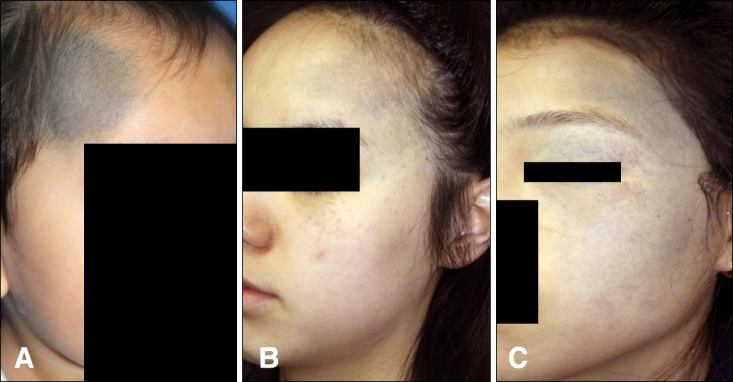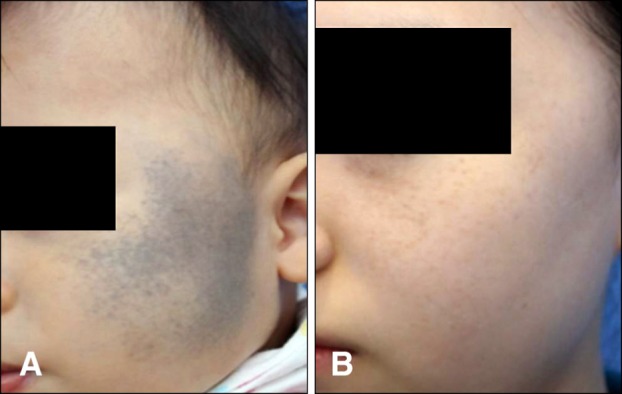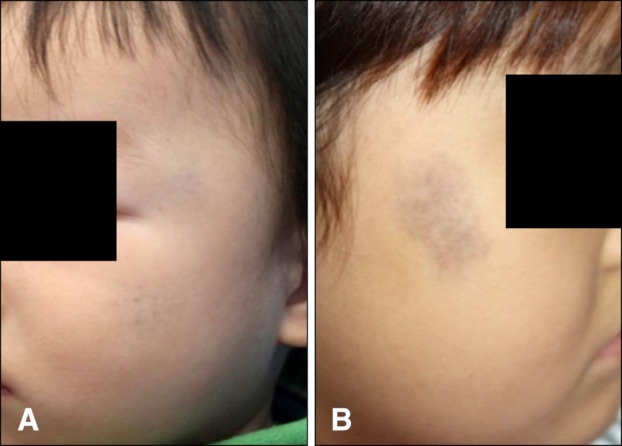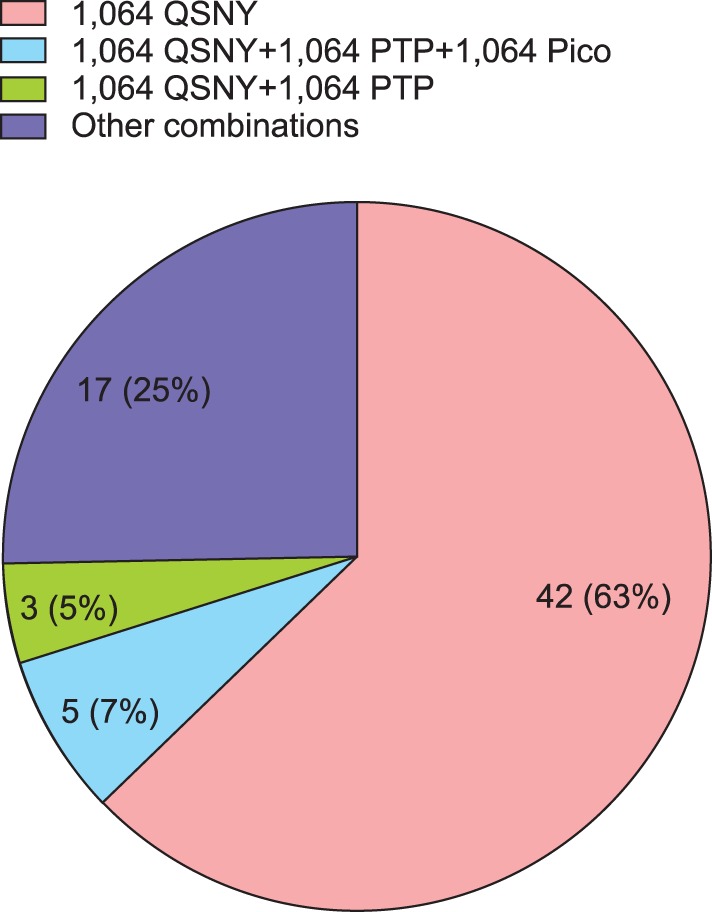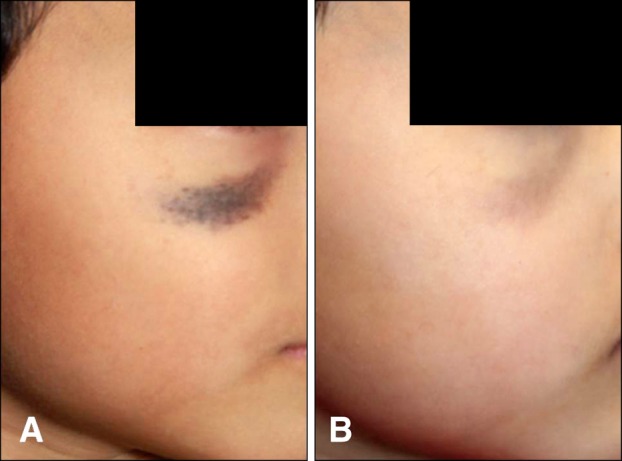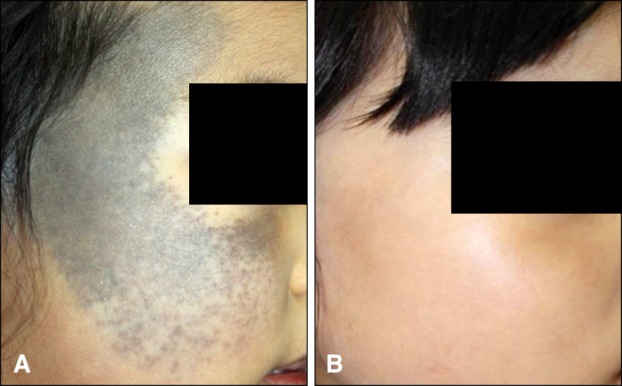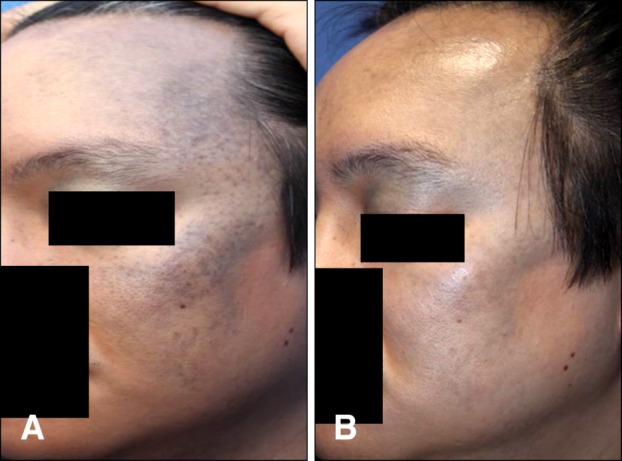Ann Dermatol.
2017 Aug;29(4):446-453. 10.5021/ad.2017.29.4.446.
Treatment and Classification of Nevus of Ota: A Seven-Year Review of a Single Institution's Experience
- Affiliations
-
- 1Department of Dermatology, Kangbuk Samsung Hospital, Sungkyunkwan University School of Medicine, Seoul, Korea. susini@naver.com
- KMID: 2388943
- DOI: http://doi.org/10.5021/ad.2017.29.4.446
Abstract
- BACKGROUND
Nevus of Ota (NO) is a relatively common pigmentary disorder in Asians. Tanino's classification is an old but tacit consensus to delineate the disease. Various treatment options have been presented. However, a few studies have been conducted on available laser options and current treatment strategies or the classification of NO.
OBJECTIVE
To investigate current laser options and their effectiveness for the treatment of NO, contributing factors to clinical outcomes, and verification of classification.
METHODS
A retrospective study of NO was conducted by reviewing medical charts and photographs of sixty-seven patients. Statistical analysis was used to compare excellent and poor outcomes and determine contributing factors.
RESULTS
The median age of onset was below the age of 1 (interquartile range [IQR], 0~1). Tanino's and PUMCH classification systems failed to classify patients in 24 (35.8%) and 6 (9.0%) of patients, respectively. A 1,064 nm Q-switched Nd:YAG laser without additional lasers was used most frequently in 42 patients (62.7%). The frequency of treatment was 19.0 (IQR, 10.0~23.0) in the cured group defined as subjects showing 95% improvement or above, compared to 10.0 (IQR, 6.25~13.75) in the unattained group defined as subjects showing less than 95% improvement (p=0.001).
CONCLUSION
A 1,064 nm Q-switched Nd:YAG laser is a reliable treatment armamentarium, functioning as a single infallible modality as well as a combination treatment modality for NO. Repetitive laser treatments without interruption seems to be the most suitable in clearing NO. The current classification systems of NO are defective. Thus, a new classification should be developed.
Keyword
MeSH Terms
Figure
Cited by 1 articles
-
Analysis of Clinical Features and Treatment Outcomes Using 1,064-nm Nd-YAG Laser with Topical Hydroquinone in Patients with Riehl's Melanosis: A Retrospective Study in 10 Patients
Chong Won Choi, Gwanghyun Jo, Dong Hun Lee, Seong Jin Jo, Cheol Lee, Je-Ho Mun
Ann Dermatol. 2019;31(2):127-132. doi: 10.5021/ad.2019.31.2.127.
Reference
-
1. Ho SG, Chan HH. The Asian dermatologic patient: review of common pigmentary disorders and cutaneous diseases. Am J Clin Dermatol. 2009; 10:153–168. PMID: 19354330.2. Wang HW, Liu YH, Zhang GK, Jin HZ, Zuo YG, Jiang GT, et al. Analysis of 602 Chinese cases of nevus of Ota and the treatment results treated by Q-switched alexandrite laser. Dermatol Surg. 2007; 33:455–460. PMID: 17430380.
Article3. Radmanesh M. Naevus of Ota treatment with cryotherapy. J Dermatolog Treat. 2001; 12:205–209. PMID: 12241629.
Article4. Kouba DJ, Fincher EF, Moy RL. Nevus of Ota successfully treated by fractional photothermolysis using a fractionated 1440-nm Nd:YAG laser. Arch Dermatol. 2008; 144:156–158. PMID: 18283171.
Article5. Ono I, Tateshita T. Efficacy of the ruby laser in the treatment of Ota's nevus previously treated using other therapeutic modalities. Plast Reconstr Surg. 1998; 102:2352–2357. PMID: 9858169.
Article6. Seo HM, Choi CW, Kim WS. Beneficial effects of early treatment of nevus of Ota with low-fluence 1,064-nm Q-switched Nd:YAG laser. Dermatol Surg. 2015; 41:142–148. PMID: 25485806.7. Ota M, Tanino H. Nevus fusco-caeruleus ophthalmo-maxillaris. Tokyo Med J. 1939; 63:1243–1245.8. Choi JE, Lee JB, Park KB, Kim BS, Yeo UC, Huh CH, et al. A retrospective analysis of the clinical efficacies of Q-switched Alexandrite and Q-switched Nd:YAG lasers in the treatment of nevus of Ota in Korean patients. J Dermatolog Treat. 2015; 26:240–245. PMID: 24888365.
Article9. Zong W, Lin T. A retrospective study on laser treatment of nevus of Ota in Chinese children--a seven-year follow-up. J Cosmet Laser Ther. 2014; 16:156–160. PMID: 24684590.
Article10. Guledgud MV, Patil K, Srivathsa SH, Malleshi SN. Report of rare palatal expression of Nevus of Ota with amendment of Tanino's classification. Indian J Dent Res. 2011; 22:850–852. PMID: 22484884.
Article11. Huang WH, Wang HW, Sun QN, Jin HZ, Liu YH, Ma DL, et al. A new classification of nevus of Ota. Chin Med J (Engl). 2013; 126:3910–3914. PMID: 24157155.12. Chan HH, Lam LK, Wong DS, Leung RS, Ying SY, Lai CF, et al. Nevus of Ota: a new classification based on the response to laser treatment. Lasers Surg Med. 2001; 28:267–272. PMID: 11295763.
Article13. Choi CW, Kim HJ, Lee HJ, Kim YH, Kim WS. Treatment of nevus of Ota using low fluence Q-switched Nd:YAG laser. Int J Dermatol. 2014; 53:861–865. PMID: 23834371.
Article14. Yoo MG, So BJ, Lee JM, Kim DH, Park HC, Ryu HJ, et al. Influence of pulse type on subcellular selective photothermolysis of melanosomes in adult zebrafish skin following 1,064-nm, Q-switched, Nd:YAG laser irradiation: a pilot study. Ann Dermatol. 2015; 27:230–232. PMID: 25834374.
Article15. Aurangabadkar S. QYAG5 Q-switched Nd:YAG laser treatment of nevus of Ota: an Indian study of 50 patients. J Cutan Aesthet Surg. 2008; 1:80–84. PMID: 20300349.
Article16. Kar HK, Gupta L. 1064 nm Q switched Nd: YAG laser treatment of nevus of Ota: an Indian open label prospective study of 50 patients. Indian J Dermatol Venereol Leprol. 2011; 77:565–570. PMID: 21860154.
Article17. Suh DH, Hwang JH, Lee HS, Youn JI, Kim PM. Clinical features of Ota's naevus in Koreans and its treatment with Q-switched alexandrite laser. Clin Exp Dermatol. 2000; 25:269–273. PMID: 10971482.
Article18. Ueda S, Isoda M, Imayama S. Response of naevus of Ota to Q-switched ruby laser treatment according to lesion colour. Br J Dermatol. 2000; 142:77–83. PMID: 10651698.
Article
- Full Text Links
- Actions
-
Cited
- CITED
-
- Close
- Share
- Similar articles
-
- A Case of Bilateral Nevus of Ota Associated with Bilateral Nevus of Ito
- A Case of Ota Nevus Associated with Altitudinal Field Defect
- Erratum: Treatment and Classification of Nevus of Ota: A Seven-Year Review of a Single Institution's Experience
- A Case of Bilateral Nevus of Ota Associated with Nevus of Ito
- The Surgical Treatment of Nevus of Ota with Ocular Involvement

